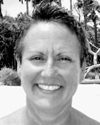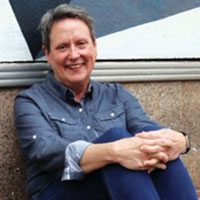 On a Delta flight from LaGuardia to Savannah, sky sailing over the Atlantic Ocean, the water as smooth and muted as a fresh coat of gray-blue paint on the plank of a new house, I read Citizen Conn, a short story by Michael Chabon published in a February issue of The New Yorker. I was not far along into the piece when I read the sentence, “I tried to think about what I was going to say to this elderly stranger with bone metastasis.” The sentence jumped off of the page sending me back to a time when we nursed my father, dying of bone and lung cancer. Until I read that sentence, I never truly considered how painful cancer of the bones must be. I think my mother understood as she cared for him day after day, and my sister knew because she gave him that last dose of morphine. I was too entangled in tasks, rosaries, and shock to acknowledge pain.
On a Delta flight from LaGuardia to Savannah, sky sailing over the Atlantic Ocean, the water as smooth and muted as a fresh coat of gray-blue paint on the plank of a new house, I read Citizen Conn, a short story by Michael Chabon published in a February issue of The New Yorker. I was not far along into the piece when I read the sentence, “I tried to think about what I was going to say to this elderly stranger with bone metastasis.” The sentence jumped off of the page sending me back to a time when we nursed my father, dying of bone and lung cancer. Until I read that sentence, I never truly considered how painful cancer of the bones must be. I think my mother understood as she cared for him day after day, and my sister knew because she gave him that last dose of morphine. I was too entangled in tasks, rosaries, and shock to acknowledge pain.
Not too long ago, my mom and I walked into the Keyserling Cancer Center to meet with Dr. James McNab, the radiation oncologist come down from Chapel Hill, North Carolina to serve our Lowcountry. Walking into Keyserling is probably not a good thing. Something ugly has surfaced and it needs to be electrocuted or poisoned. Overall, we are fortunate. My mom’s breast cancer was small, detected early, and removed via a lumpectomy on Thanksgiving Eve by the talented hands of Dr. Perry Burrus. But sixteen days of turning from Ribaut Road into the entrance of the cancer center was still required, giving me pause from the norm of everyday life.
When Irene first started radiation on January 3, I was in high gear to begin work in the New Year, charged up after a long Christmas break. Between Christmas and New Year’s Day, my mom had been fitted with the plastic cup that would isolate her left breast and she had successfully completed her “practice run” on the table. If nothing else, I am a planner, and I set deadlines for her treatments and appointments. The fact that we had to manage sixteen treatments, and could not opt for the intensive one week, twice a day regimen, blew our initial hopes for a short engagement with Keyserling. In reality, we got off easy. Most folks endure radiation for six weeks.
On Irene’s first day of treatment, I had my iPhone in one hand and my iPad tucked under my arm. My mom headed off to the back rooms; I sat down and got to work. Day One over. Day Two and Three were the same. Somewhere around Day Four, I started to look up from my devices and see the people that were coming in and out of the sliding glass doors – young and old faces, black and white, people walking and in wheelchairs, some alone, but most with a partner or a friend, a spouse, or an adult child. I noticed my surroundings. The walls are painted in shades of blue and green and outlined in goldenrod yellow. One wall is a sheet of gurgling water; a rippling sculpture intentionally placed beside the doors leading to radiology, a soft, clear cascade of liquid serenity. There are black fans rotating overhead like airplane propellers that never quite leave the ground for heaven.
On Day Five, my mom invited me back to witness a radiation session. The Varian Radiation System inhabits the entire room and has the aura of an alien spaceship. It emits 6 MV (mega volts or 6 million volts!) in its quest to dislodge electrons from atoms, attacking bad and good cells alike. Irene has to be exactly positioned, and the union of her back, fragile with stenosis and thinning skin, with the narrow, stainless steel table, was uncomfortable. It was her single complaint about the therapy.
A branch of Beaufort Memorial Hospital, the cancer center is new, clean and only ten minutes from our house on Lady’s Island. The staff is exceptional, and dedicated volunteers assist at the front desk. Everywhere you turn, there is an air of compassion and calm. There is hot coffee available and I appreciated having it every day as I sat and waited. Somewhere around Day Six, Seven or Eight, I made a fresh pot and picked up stray sugar packets from the floor that had missed their target. Reading material (The Lowcountry Weekly) is in the waiting area, but I was struck by new titles and publications with titles like Cancer Today, Living with Cancer and Chemotherapy. On Day Nine, I delivered The Beaufort Gazette and the USA Today to the lobby tables. When we left, I was gladdened to see someone paging through the newspapers.
During Days Eleven through Thirteen, I was out of town on business. Our neighbor Diane, and my mom’s helper and new friend Terri took care of getting Irene to Keyserling, a welcome change of pace from the mother-daughter duo and routine. By Day Fourteen, I had only my iPhone and a little notebook in hand. On Day Fifteen, I brought magazines to the Center and continued my compulsive habit of picking up wayward sugar packets.
Finally, Day Sixteen arrived. During our consultation with Dr. McNab after my mom’s last treatment, Irene commented on her wonder that this cancer had infiltrated an almost 80 year old woman. In a calm and gentle voice, McNab simply said, “Cancer isn’t fair,” and gave her a congratulatory hug for having completed her therapy. Odds are that if or when another lump appears, it won’t happen for three years. Anything can happen over three years. Diabetes, colitis and macular degeneration have taught us that much.
I don’t remember if we had lunch on Day Sixteen, but I know that after Dr. McNab left the examination room and my mother had dressed, we exchanged a long hug. We had both changed. The side of my mother’s chest was a rosy red and hopefully, the remainder of any aggressive and malignant cells had been “cooked” as she liked to say. I had slowed down. I took time to meet Ruth, a woman who drove her husband every day from Hilton Head. I wasn’t in a hurry to check my emails when I sat down to wait. I saw the faces of the people at Keyserling.
That evening, I opened a book I have in my “bathroom library” entitled Prayers for Healing, and the daily reading was by Marion Woodman. It was a prayer she had written “before going to the Cancer Clinic for my first radiation treatment.”
Please be with me. Please be my shield. Shield out all the radiation that is unnecessary to my healing; keep me open to the radiance that will make me whole. Keep me open to what is creative, closed to what is destructive. Into thy loving arms I commend my spirit.
On that Saturday morning flight from New York to Georgia, I noticed pinpoint rainbows of light on the cabin wall next to my seat. Sunlight poured through the oval window and caught the cuts in my diamond engagement ring creating tiny lights like daylight stars held together in their own constellation, their appearance and movement controlled by my hand. Radiation is a bit like that – tiny rays of invisible, searing light, controlled by machines and people, using the human body as a landing pad.
Cancer isn’t fair. The day my mother was diagnosed, her surgeon made certain to tell me that the chances of my sister and me contracting breast cancer had just risen fifty percent. Cancer has robbed me of a parent, a grandparent, my father-in-law, an aunt and an uncle, a cousin and co-workers. She is cruel and complicated. Cancer can be quick, or she can linger. I see her as a veiled thief – silent, sneaky, and heartless about what she takes. She caused me to slow down, enough to consider pain, and light, and the random appearance of tumors and sugar packets.






